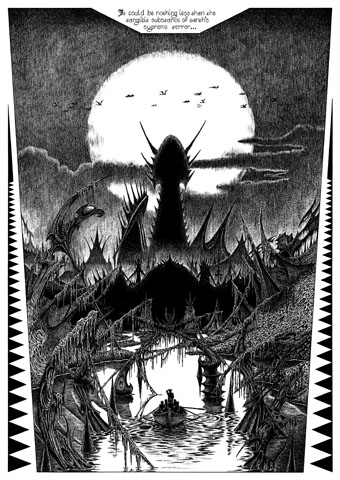
The Call of Cthulhu (1988): in the upper half there’s the big sun from Bob Peak’s poster for Apocalypse Now, in the lower half a radical reworking of Arnold Böcklin’s The Isle of the Dead.
In 1990, shortly after the first season of Twin Peaks had finished showing in the US, Video Watchdog magazine ran a feature by Tim Lucas which attempted to trace all the various cultural allusions in the character names and dialogue, references to old TV shows, song lyrics and the like. This was done in a spirit of celebration, with Lucas and other contributors welcoming the opportunity to dig deeper into something they’d already enjoyed. This week we’ve had a similar unravelling of textual borrowings in a TV series, only now we have the internet which, with its boundless appetite for accusing and shaming, can often seem like something from the grand old days of the Cultural Revolution.
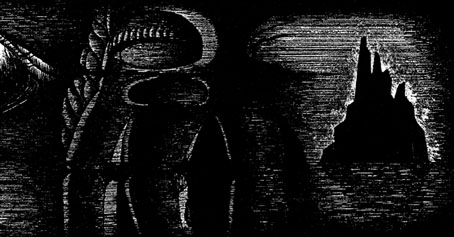
The Call of Cthulhu (1988): a more subtle allusion to Apocalypse Now.
The latest culprit ushered to the front of the assembly for the Great Internet Struggle Session is Nic Pizzolatto whose script for True Detective has indeed been celebrated for its nods to Robert Chambers and The King in Yellow. It’s also in the process of being condemned for having borrowed phrases or aphorisms from Thomas Ligotti’s The Conspiracy Against the Human Race (2011). See this post for chapter and verse.
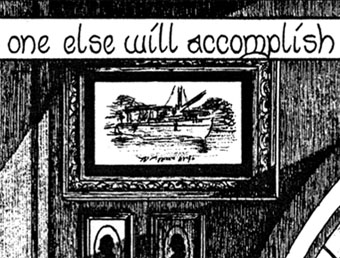
The Call of Cthulhu (1988): It’s not very clear but that’s a boat from The Creature from the Black Lagoon.
If I find it difficult to get worked up over all this pearl-clutching it’s because a) it shows a misunderstanding of art and the way many artists work; b) True Detective was an outstanding series, and I’d love to see more from Pizzolatto and co; and c) I’ve done more than enough borrowing of my own in a variety of media, as these samples from my adaptation of The Call of Cthulhu demonstrate, a 33-page comic strip where there’s a reference to a painting, artist or film on almost all the pages, sometimes several on the same page.
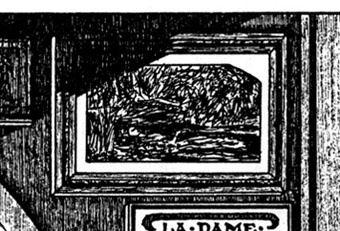
The Call of Cthulhu (1988): Ophelia by Millais.
Cthulhu is a good choice here since Pizzolatto’s story edged towards Lovecraft via the repeated “Carcosa” references. You’d think a Lovecraft zine of all things would know better than to haul someone over the coals for borrowing from another writer when Lovecraft himself borrowed from Robert Chambers (and Arthur Machen and others), while “Carcosa” isn’t even original to Chambers’ The King in Yellow but a borrowing from an Ambrose Bierce story, An Inhabitant of Carcosa (1886). Furthermore, Lovecraft famously complained about his own tendencies to pastiche other writers in a 1929 letter to Elizabeth Toldridge: “There are my ‘Poe’ pieces and my ‘Dunsany pieces’—but alas—where are any Lovecraft pieces?”
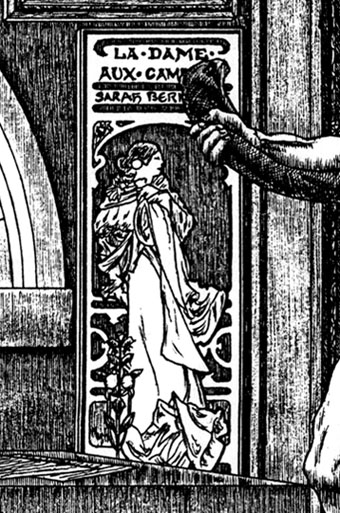
The Call of Cthulhu (1988): A poster by Alphonse Mucha.
I’ve not read the Ligotti book that’s at issue here, but I did spot a paraphrase of William Burroughs in one of Pizzolatto’s Rust Cohle monologues. “Oh, cool, he’s read Burroughs!” was my immediate thought, not “Where’s me pitchfork?” Burroughs, of course, borrowed lines and phrases from other writers throughout his career: in The Ticket that Exploded rather than explain the actions of an alien organism he simply inserts two suitable paragraphs from a Henry Kuttner story; the opening Invocation from The Cities of the Red Night borrows some of the demon descriptions from the Simon Necronomicon. Burroughs’s attitude to other people’s work may be an extreme example (see also Kathy Acker who was always open about her textual thefts) but artists are continually borrowing themes and ideas, riffing on other works, quoting and appropriating. If you make art of any kind this shouldn’t need to be explained, the only people who are shocked when discovering this are those who want “true” art to be the product of a stainless originality.
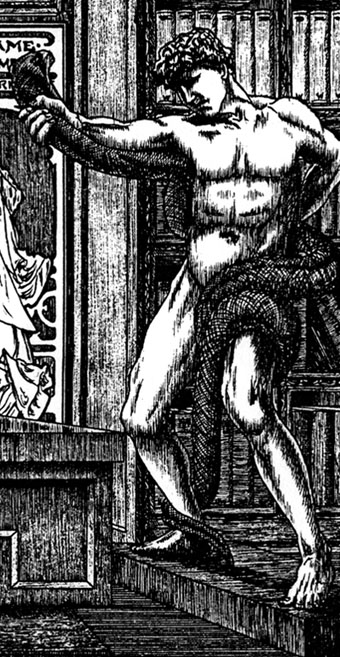
The Call of Cthulhu (1988): An Athlete Wrestling with a Python by Frederic Leighton.
For my part, The Call of Cthulhu was heavily referential because I enjoyed making these allusions, and it was also a way of making the adaptation thematically richer. The references to Joseph Conrad and Apocalypse Now were a nod to Heart of Darkness, another story about a journey by boat to “one of the dark places of the Earth”. So too with King Kong, a story about a lost island that’s a home to monsters. Art is often a conversation, between artists and between different artworks, past and present. The borrowing doesn’t always have to serve as an homage or a reference that everyone ought to understand, sometimes you merely want some intangible quality of otherness from the borrowed thing in your own work, something to throw you off the familiar paths you might otherwise tread.
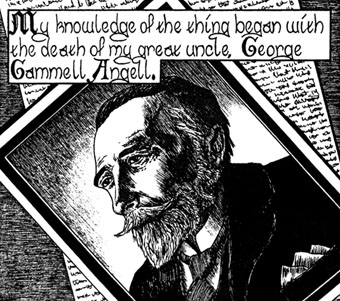
The Call of Cthulhu (1988): Joseph Conrad.
Now that this Ligotti connection has come to light it’s increased my appreciation of True Detective. It makes the series seem even more of an unlikely smuggling of the True Weird into the mainstream, a rare and difficult feat when so much popular entertainment is increasingly inane, unambitious and juvenile. I’m looking forward to the second series.
More of my own outrageous thefts follow.
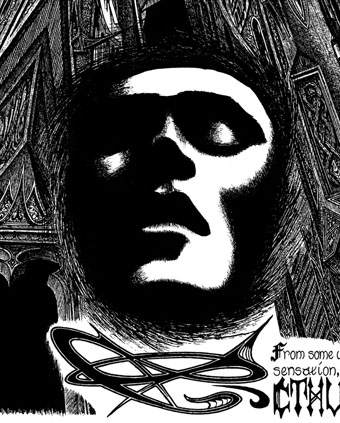
The Call of Cthulhu (1988): The face from Parsifal by Jean Delville.
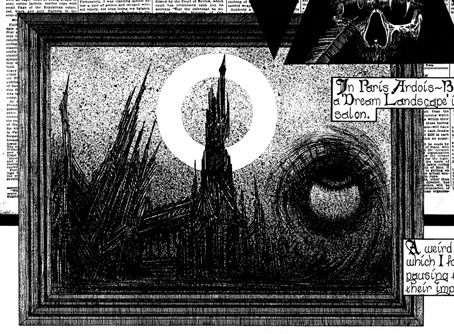
The Call of Cthulhu (1988): Max Ernst and Odilon Redon, together at last.
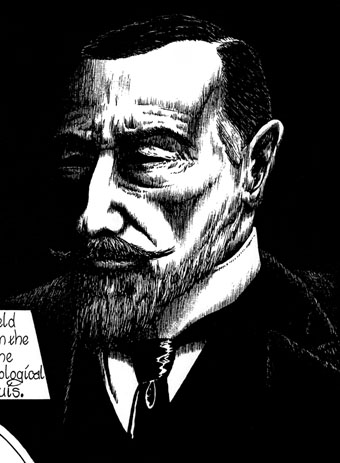
The Call of Cthulhu (1988): Joseph Conrad again (and not a very good portrait).
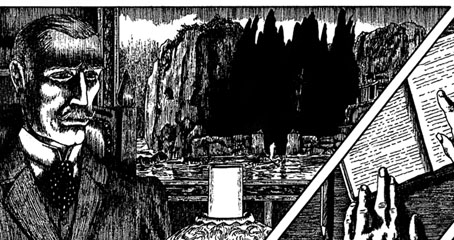
The Call of Cthulhu (1988): The Isle of the Dead by Arnold Böcklin.

The Call of Cthulhu (1988): A frame from King Kong reimagined as a Louisiana swamp.
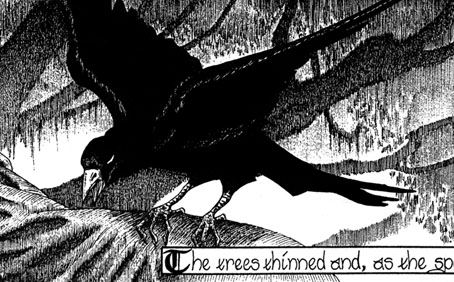
The Call of Cthulhu (1988): Bird borrowed from an alchemical illustration.
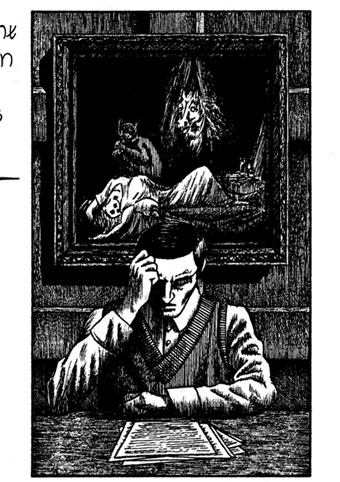
The Call of Cthulhu (1988): The Nightmare by Henry Fuseli, one of Lovecraft’s favourite artists.
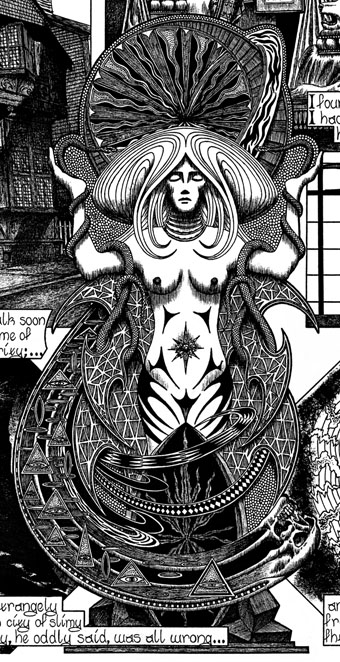
The Call of Cthulhu (1988): Shades of Gustav Klimt.
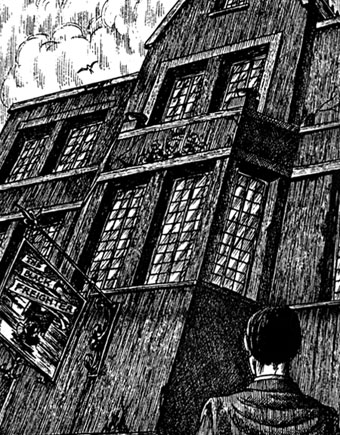
The Call of Cthulhu (1988): The inn sign is a copy of one of the Tales of the Black Freighter panels in Watchmen.
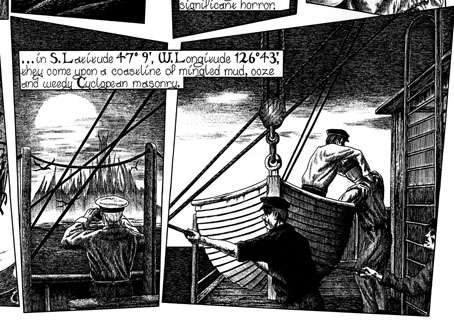
The Call of Cthulhu (1988): Two more frames from King Kong.
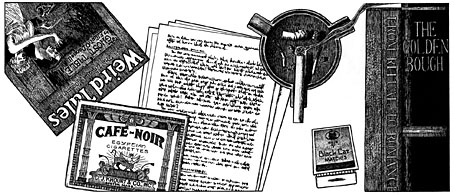
The Call of Cthulhu (1988): Intertextuality overload: on the left, the edition of Weird Tales in which The Call of Cthulhu first appeared; on the right, two of the books seen on Kurtz’s desk in Apocalypse Now. Those books are there because they’re two of the volumes mentioned by TS Eliot in his notes to The Waste Land. Why Eliot in Apocalypse Now? Because he has a quote from Heart of Darkness at the opening of The Hollow Men, a poem Marlon Brando reads in the film. The Waste Land is, of course, very famous indeed for being a poem-collage of quotes and allusions to other poets, dramatists, etc.
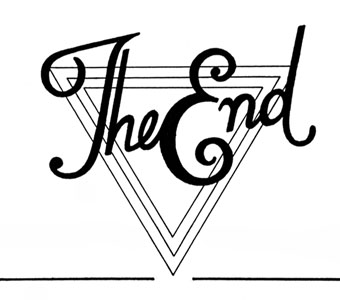
The Call of Cthulhu (1988): This was an RKO picture. Mind how you go.
Elsewhere on { feuilleton }
• The Lovecraft archive

I’m with you John. Anything that rescues Robert Chambers from obscurity is fine with me. And I’m a huge Ligotti fan. “The Conspiracy Against the Human Race” is not a good one for newbie’s though. It’s a work of mad philosophy and not for the faint-hearted. Delighted though to report that Subterranean Press has just published a collection of new stories from Ligotti after a long hiatus.
I’m sure all the publicity will benefit Ligotti so that’s to the good. Of his books I’ve only got Songs of A Dead Dreamer, I ought to read some more.
Re: Did the writer of “True Detective” plagiarize Thomas Ligotti and others?
I think, generally speaking, you can sense works that are a homage or a multi-influence collage or a pastiche or a lampoon or a multi-allusionary exercise as the normal rough and tumble of art creation, appreciated as examples of the synchronised shards of random truth and fiction or some Jungian unconscious.
Rarely, though, one can sense a work changing into another gear, where it focuses too heavily or where a line is crossed, even if done inadvertently. As Jon Padgett and Lovecraftezine have described it, this seems to apply to the current Ligotti – True Detective issue, especially when, in the aftermath, fences could have been mended so easily.
A few years ago I thought the TV series ‘Life on Mars’ crossed that line vis-a-vis Christopher Priest’s earlier novel ‘The Affirmation’.
“The series now seems even more of an unlikely smuggling of the True Weird into the mainstream, a rare and difficult feat when so much popular entertainment is increasingly inane, unambitious and juvenile.” To me though, True Detective seems remarkably tame in this regard in comparison to what Twin Peaks achieved a couple of decades ago – at a time when the climate in network television was vastly more conservative and unadventurous. Part of the reason why I think the show was ultimately a disappointment – despite being frequently outstanding – was that it seemed to use the Weird as a form of window-dressing to spice up what turned out in the end to be entirely generic. Its flirtations with Ligottian pessimism were all rinsed away in a not very convincing piece of rhetoric about the night sky; the King in Yellow couldn’t have been a more generic boogeyman (a disfigured janitor leering at children in a playground, and yet another Ed Gein/Thomas Harris/Leatherface castoff); and anything that departed from the standard parameters of the serial killer procedural could be safely written off as Cohl having an acid flashback (like if they’d written off the Black Lodge in TP as being a by-product of Cooper’s heavy caffeine and pastry intake).
I’m with you on this, John. In fact, you stated much of what I was thinking in the wake of reading the accusations. I saw the specific examples of borrowing and they fit within the long tradition of authors and artists borrowing from others who came before them. I do not see anything that “crosses the line” into outright theft.
Thanks for this great post!
Thank you,John, for clearing the air about this issue of alleged plagiarism by Nic Pizzolato. I followed the discussion and was frankly confused. What is the line between plagiarism and artistic license. Are Lovecraft, Burroughs, T.S. Elliot, you plagiarists? I think not.
As for Mr. Pizzolato, we should give him the benefit of the doubt before rushing to judgement. True Detective put weird fiction out front and led many viewers to Ligotti, Laird Barron, Chambers, Karl Edward Wagner and others. That is a good thing, but the allegations, which are debatable, are a tempest in a tea cup in my opinion.
Des: I’d judge the totality of a work before accusing anyone of plagiarism, so on that score True Detective is far more than the sum of its borrowed parts. Pizzolatto could have left out the Carcosa and other material and the series would still have been an exceptional piece of work, not least because of the performances, the direction, the music and so on. The same applies to the references in my Lovecraft adaptation: they didn’t need to be there, the thing would be just as effective without them, but adding them takes the piece as a whole to a different level. Copying is less excusable for me when it’s this kind of laziness:
http://www.johncoulthart.com/feuilleton/2008/01/24/design-as-virus-3-the-sincerest-form-of-flattery/
Tristan: If network TV (and Hollywood) is less conservative now than in 1989 then I’d ask where the equivalent of Twin Peaks is today? As I recall, Mulholland Drive was originally a pilot for a TV series that one of the networks rejected. Lynch’s last few films were financed by the French so there’s little love for him in LA despite his filming there. I didn’t pay any attention to True Detective at first because it sounded like more of the same: two cops chasing down a serial killer (a description that could also apply to Twin Peaks). I only took notice when The King in Yellow was mentioned; as I said to Des, they could easily have avoided any of that and still been successful: Matthew McConaughey’s performance was remarkable.
HBO doesn’t stray very far from the familiar: Scorsese-like gangsters in The Sopranos, the Wild West in Deadwood, urban crime in The Wire, vampires in True Blood, epic fantasy in Game of Thrones, with all those series following the old exploitation formulas of regular sex and violence. They’re all essentially superior pulp, as is True Detective which even has a pulpy title; but there’s good pulp and bad pulp, and we get more than enough of the latter already in shitty action movies and the like. I’m surprised that people seem so eager to kick Pizzolatto for smuggling this outré material into areas that usually shun it outright instead of encouraging him to do more and go further. What’s preferable: True Detective 2 or Transformers 5, 6, 7 ad nauseam?
Borges already wrote the best story about plagiarism didn’t he?
http://en.wikipedia.org/wiki/Pierre_Menard,_Author_of_the_Quixote
Your work is so beautiful. References and resonances in a work of art give it more layers and sort of create a “world” for it to live in, I think.
Also, I have a question for you and for your readers: is Tim Lucas’s Video Watchdog piece is available digitally? I would love to read it!
Thanks, Katie. Looking at Video Watchdog’s site it seems they’re still selling reprints of the Twin Peaks issue (no. 2) so I doubt they’d put the article online. I wouldn’t be surprised, however, if many of the speculations are now duplicated on the many Twin Peaks sites. When that issue of VW appeared nobody had written about the series in any detail but it was soon followed by Wrapped in Plastic magazine which was devoted to nothing but Twin Peaks.
Excellent post, John. One of very many. I’ve never commented here before, but I am a huge fan of your blog!! Just wanted to say, keep up the good work! Cheers!
Thanks, Allan.